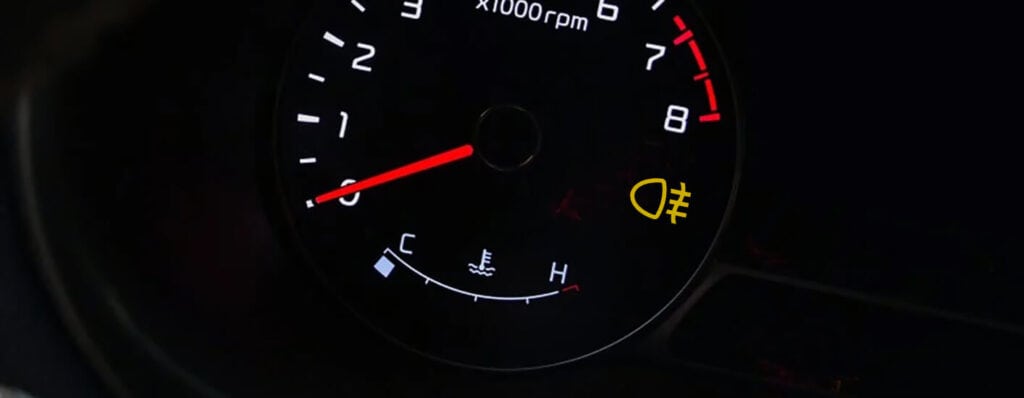The Illuminating World of Fog Lights
Fog lights are more than just fancy additions to a car; they serve a crucial purpose. They cut through challenging weather conditions, ensuring visibility and safety. As essential as they are, it’s imperative that every driver acquaints themselves with these luminous tools, understanding their function and significance.
Deciphering the Dashboard: Understanding the Fog Light Symbol
• Dashboard Iconography: The fog light symbol is a distinct icon located on your car’s dashboard.
• Illuminated Beacon: When this symbol lights up, it indicates the activation of your fog lights.
• Visual Distinction: At a cursory look, it might resemble a regular headlight icon, but it has its unique design.
• Functionality Indicator: The lit-up symbol doesn’t just signify its activation; it underscores that the vehicle’s fog lights are working and in operation.
• Differing from Regular Headlights: Fog lights and regular headlights have different designs and serve distinct purposes when it comes to illuminating the road.

The Science Behind the Shine: Purpose and Functionality of Fog Lights
Driving in low visibility conditions can be nerve-wracking, but thanks to the engineering behind fog lights, drivers can breathe a little easier. These lights are specifically designed to emit a unique pattern of light, which is both wide and low. This design ensures that the beam efficiently cuts through the thick mist or fog, offering a clearer view of the road ahead. Unlike the piercing beam of regular headlights, which often bounces off fog particles creating a glare, fog lights aim to minimize this reflection.
The placement of fog lights, generally lower on the vehicle, plays a significant role in its effectiveness. By illuminating the ground directly in front of the car, they offer an unobstructed view, which can be particularly beneficial in situations where fog is dense near the surface. It’s this dedicated engineering that sets fog lights apart, making them not just an optional accessory but a crucial component for safe driving in compromised conditions.
Guidelines for Use: When to Turn on Your Fog Lights
• Not Just for Fog: While named “fog lights,” their utility isn’t limited to foggy situations alone.
• Visibility Compromised: Be it rain, mist, or heavy snow, anytime visibility drops, fog lights are your go-to.
• An Extra Layer of Safety: These lights are specially designed to provide better visibility in challenging conditions.
• Caution with Usage: It’s vital not to use fog lights as a replacement for regular headlights when conditions are clear.
• Risk of Blinding Others: Over-relying on fog lights in clear conditions can pose a risk to oncoming drivers due to their angle and brightness.
Automatic Operations: The Integration of Sensors and Modern Fog Lights
As technology continues to evolve, so does the world of automotive design. Modern vehicles have transcended manual operations in many aspects, and fog lights are no exception. Today, many cars are equipped with sophisticated sensors that continuously monitor ambient conditions, assessing visibility levels on the go.
When these sensors pick up on decreased visibility due to factors like fog, rain, or dust, they can send a signal to automatically activate the fog lights. This not only enhances safety by ensuring the lights come on exactly when needed but also provides convenience for the driver. There’s no longer a need to fumble for switches or remember to turn on the fog lights manually in unpredictable weather. The car does it for you, ensuring optimal visibility at all times.
Nighttime and Fog: The Dual Utility of Fog Lights
Fog lights, contrary to their name, are not limited to just foggy conditions. They have a dual utility that many drivers might not be fully aware of. Their design and positioning make them ideal for enhancing visibility during nighttime drives. By casting a beam that’s closer to the ground, they help in illuminating the immediate road surface more effectively than regular headlights.
This unique lighting angle is especially beneficial in rural or less lit areas, where obstacles like potholes, road debris, or even animals can suddenly appear. The extra layer of illumination that fog lights provide ensures that such potential hazards are spotted in time, allowing the driver to take necessary precautions. It’s this versatility of fog lights that underscores their importance, making them an invaluable tool not just for foggy days, but also for those dark, moonless nights.

Maintenance and Costs: Keeping Your Fog Lights in Top Shape
• Safety Priority: Keeping fog lights operational is not just about functionality; it’s a safety necessity.
• Regular Check-ups: Periodic inspections can help detect any issues early on, ensuring the lights function when needed most.
• Bulb Replacements: Over time, like all bulbs, fog light bulbs might need replacement.
• Sensor Calibrations: Modern cars with automatic fog light activation might require sensor calibrations occasionally to ensure optimal functioning.
• Cost-Effective in the Long Run: While there might be some costs associated with maintenance, it’s a worthwhile investment considering the safety benefits and potential savings from preventing more significant issues down the road.
Conclusion: Navigating the Fog with Confidence
Fog lights are more than just an accessory; they’re a beacon in challenging weather, guiding us safely on our journey. As you venture through thick mists or dark roads, it’s essential to have a reliable partner. If you ever find yourself in need of expert guidance or fog light services in Canada, remember that Uchanics mobile mechanic services are just a call away, ready to illuminate your path.
